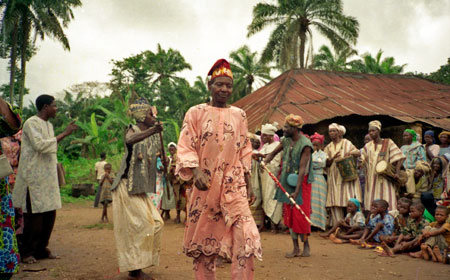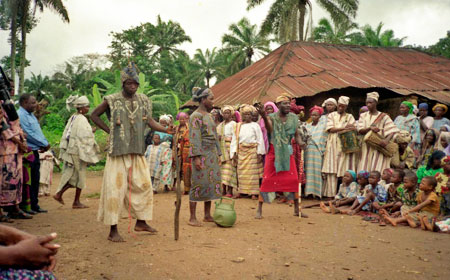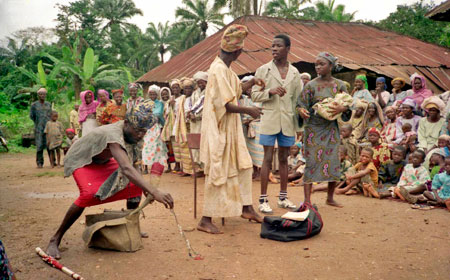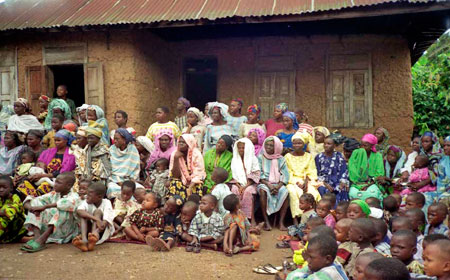Photo Essay: Developing Locally Relevant Theatre in Nigeria
by Alfonso Gumucio-Dagron
Drama was one of the earliest forms of cultural expression in communities all around the world. Theatre is in the tradition of all cultures, even the most marginalised. However, the potential of theatre as a communication tool has been underestimated. Yes, street theatre or community theatre has been part of larger communication processes, but rarely have they been at the centre of the strategy.
We know of many experiences in which one drama group has been working on a development initiative during a limited period of time, and even of groups that have been working for years in promoting health or education in developing countries.
In those cases, theatre groups usually participate in performances once or twice a week, and they often have a very limited reach, in terms of audience. Also, the content of their plays is rarely adapted to the local needs of communities and to the local culture.
The Network of Educational Theatre (NET), which started in Nigeria in 1990 with support from UNICEF, had a very different ambition: to reach thousands of people by training dozens of community groups who then developed their own plays presented in local languages and adapted to the local culture. These community drama groups would perform on a daily basis—not randomly but systematically.
The main challenges of this initiative were to establish a permanent system of communication through drama groups — self-sustained, cost-effective and locally relevant — to promote health issues in areas of Nigeria where not even television or radio had coverage. And, even in the areas reached by mass media, the challenge was to develop a participatory approach through which people in communities would take ownership of health problems and solutions.
First, actor-director Jimmi Solanke trained community theatre groups. I developed and published a training manual called Popular Theatre. And a dozen scripts were developed based on the Facts for Life, an important reference on the main causes of morbidity and mortality worldwide. The book has been adapted and translated into four Nigerian languages, and thousands of copies were disseminated throughout the country.
Second, drama groups were trained through intensive 10-day workshops. The training was not random training: Each new drama group formed at the local level was the result of a participatory process of selection within and with a specified Local Government Area (LGA) as well as with community leaders and artists. From the beginning, members of the newly formed drama groups were told that full dedication was required since this was not going to be a minor activity in their lives. While Jimmi Solanke and his troupe conducted the training in southern states of Nigeria, in the Northern states theatre professionals from Ahmadou Bello University in Zaria conducted the training.
In about two years, Solanke and his team trained 46 LGA drama groups. Scripts were adapted to local contexts, and specific agreements were signed with local government authorities to ensure that, at least for five years, seed funding would be provided by the LGA to support each drama group until it became self-sustainable. Also, a monitoring and evaluation system was developed to allow follow-up of each drama group. This system included feedback from each community where drama groups would perform.
Third, each drama group performed, using an itinerary covered by the LGA, including dozens of communities to be served one after the other for 20 days each month. The drama group would stay overnight, hosted by people of the community, before travelling to the next village the following day. A rough calculation suggested that if all 46 drama groups trained would perform 20 days per month in 20 different villages in front of an audience of 200 people on average, by the end of each month, 920 performances in an equal number of villages would have reached 184,000 people.
Each performance was a community event.

Drummers from the local drama group would arrive at a particular village, entering from various parts of the village, calling people’s attention with songs and music and converging at the village centre. There, a large circle would be drawn on the floor or a square between a number of tall trees to allow for enough space for the drama group and for the villagers to sit.

While preparing the performance, actors would have early discussions with villages and community leaders to learn more about local events and characters that could be incorporated, in an improvised manner, into the performance, with the purpose of creating a bond with the audience.

The play itself was a mix of drama, songs and dialogue with the people, on the issues identified in the script.

For example, the play on guinea worm disease —one of the main causes of morbidity—would highlight the impact of the illness on the local economy, since it prevented men and women from working.

The play would stop at any moment to ask people questions or to let them say what they knew about guinea worm, tell their own experience and discuss how to prevent it.
Once the play ended, actors, musicians and villagers would dance and chant, as they usually do after performances. In several villages where I witnessed these performances, I saw many people approaching the actors and sticking on their forehead 20 Naira bills (about $1 US at the time) in a sign of appreciation. This gesture, known as “spraying,” was incorporated as one of the sources of the drama groups’ income and economic sustainability.
Lynn Geldof, an Irish journalist who later became UNICEF staff, was a consultant at the time and wrote Community Empowerment, a book covering the various participatory initiatives UNICEF supported in the early 1990s in Nigeria. One chapter describes the popular theatre network as a third channel to “communicate, inform and educate.” According to Geldof, the potential of popular theatre “is far greater than any other because it is at once intimate, immediate, accessible and full of cultural resonance in which the seeds of new knowledge can take root: the message has a life beyond the performance.”


